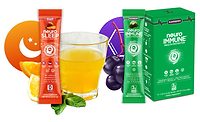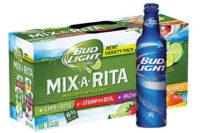FSMA regulations increase importance of traceability
Reusable container manufacturers incorporate RFID, cloud-based tracking

For beverage-makers, the quality and safety of their products are among the top priorities for their brands. When those aspects are threatened, locating and removing tainted products is one of the first steps executed. However, an analysis of the supply chain also can prove valuable as beverage companies and their distributors ensure the efficacy of products.
The growing impact of traceability throughout the supply chain also has been heightened by regulations such as the U.S. Food and Drug Administration’s (FDA) Food Safety Modernization Act (FMSA), which had its first major compliance dates take effect in September 2016, impacting large businesses to comply with certain new standards. Among those that took effect were that human food facilities must meet preventive controls and Current Good Manufacturing Practice requirements (CGMPs).
For consumer packaged goods (CPG) companies, the material handling products that they use to distribute their brands also is garnering attention as brand owners look to comply with regulations, according to industry suppliers.
“Food safety is one of the broadest issues impacting the returnable container market,” says Toni Soale, marketing communications manager for Buckhorn, Milford, Ohio. “The Food Safety Modernization Act has driven customers to look more closely at eliminating wood and cardboard from their operations in an effort to prevent contaminates from being introduced into their systems.”
Additionally, traceability throughout the supply chain can aid in these compliance and preventative measures, according to industry suppliers. Reusable packaging system manufacturers already are instituting technology and customer service procedures to further these goals.
One of the components of the Food Safety Modernization Act is traceability throughout the supply chain system says Justin Hermsen, senior product manager at ORBIS Corp., Oconomowoc, Wis. “The ability to track products as they move from source to shelf will be important so suppliers are able to look back and identify where that product came from, and where it has been,” he says.
However, Hermsen notes there are different ways to view of traceability when it comes to reusable packaging containers. “There’s traceability where the main goal is being able to identify product origin, and there also is being able to track the movement of goods to their final destination to ensure delivery and return of packaging,” he explains.
More and more reusable packaging container suppliers have implemented radio frequency identification (RFID) tracking within their shipments to determine product location.
“Returnable packaging is an ideal solution because of the return on investment,” Buckhorn’s Soale says. “However, tracking plays an important role. Specifically, it reduces the need to replace containers, saving the customer both time and money. All of our Calibers Intermediate Bulk Containers come standard with an RFID system for tracking. This eliminates a manual barcode system, and it allows customers to know where their assets are at all times.”
Yet, packaged beverages are not the only products throughout the beverage market for which tracking capabilities are recommended. For the brewing industry, draft and specifically keg traceability, is gaining in prevalence as more brewers enter the U.S. market.
“We have seen time and time again both the mid-brewers and the large multi-national brewers want to always know what beer is out in the market that may be out of date or have traceabilities [so] that they’re able to pull something out of the market in case there’s an issue,” says Scott Moorad, vice president of business development and strategy for Satellite Logistics Group (SLG). “When you’re talking about bottles or cans, you have a print on that case that allows you to trace it much easier. You don’t have that nearly as easily with kegs.”
To help meet demand, Houston-based SLG offers its Kespediter keg management solution, a reverse-logistics solution to optimize asset usage and reduce shrinkage.
“We’ll show up to a wholesaler, and they’ll pick up maybe 30 different brands at a time, so instead of having to wait for a keg [and] for one brewer to have a full truckload pallet of kegs, you now can say ‘I’m going to show [up] and pick up 20 different brands
of kegs at the same time,’” Moorad says. “What that allows is now you can operate with 10, 20 even 30 percent less kegs.”
SLG took traceability to the next level when it acquired Keg ID asset-tracking technology last year and incorporated it into its Kespediter service. Using a Bluetooth scanner, smartphone or tablet, customers can scan each keg or pallet to identify where each keg is, what’s in it and how long it has been gone, the company says.
The influence to incorporate a software program like Keg ID came from the influx of participants in the U.S. beer market, Moorad explains.
“This proliferation of brewers has made it much more difficult for wholesalers, and even consumers, that are really managing [and] understanding all these brands,” he says. “It also complicated our process inside of our warehouses that are handling all these kegs. We really started using Cloud computing, real-time Cloud computing as well as mobile.
“We’re about to roll out our first pilot in our Houston warehouse,” Moorad continues. “We’re actually shifting to our receiving guys. We have iPads that receive all the different brands, check them, eliminate strays, begin to scan for the customers that are at the asset-level scan, so [we offer] a complete graduation to next level technology to support the brewers in all of this.”
Going forward, Moorad anticipates that traceability will increase for the keg market, and in 10 years he predicts that every brewer will be tracking their kegs. “It’s going to minimize loss; it’s going to start driving more accountability of who has my kegs,” he notes.
Brian J. Lindell, vice president of the beverage division for Rehrig Pacific Co., Los Angeles, also touts the efficiencies that can be achieved with reusable packaging containers and points to a market test conducted by the company.
“[R]ehrig Pacific Co. conducted a market test and tracked 200,000 20-ounce and 2-liter reusable containers for a large CPG firm for a two-year period,” he says. “Passive RFID tags and readers on production lines were installed to ensure accuracy. Data and insight gained from this test showed how often reusable containers move through the supply chain.”
Lindell notes that the market test showed most CPG manufacturers were unaware of just how frequently assets move through a supply chain.
“When asked, most [CPG manufacturers] answered six to seven times per year in a direct-store-delivery model,” he says. “However, results of the test showed both the 20-ounce and 2-liter containers turned an average of 12 times per year, nearly two times the industry assumption. During the 100 days of summer, it was not uncommon to see assets turn once every five days. What this shows CPGs is how efficient and economically valuable reusable packaging can be for lowering costs per case.”
Lindell adds that this market test has helped Rehrig Pacific when it advises companies in regards to float size, the reusable packaging necessary to support a given sales level.
“We can advise customers to spend less capital on reusable packaging floats, when utilization rates are high,” he explains. “This means less waste, or idle inventory, and a more efficient system. Additionally, if loss of reusable containers is an issue, tracking can lead to the area of the last read, providing guidance as to where to look for holes in recovery of the supply chain.”
Sustainable support
Although distributors and brands have reaped the benefits of reusable packaging systems that have resulted in advancements in traceability measures, sustainability goals and the ability in which to achieve them also have progressed, industry suppliers note.
“Economic and environmental sustainability goals can be achieved,” Lindell explains. “When CPGs have the ability to reuse containers, they possess the ability to continuously lower their cost per case. A customer invests in the asset and continues to reuse the asset until the end of its life, which can be an extremely long time.”
Lindell points to a lifecycle analysis that Rehrig Pacific conducted several years ago, which compared the environmental impacts of delivering product utilizing reusable containers with one-way packaging that included tray shrink and cardboard tray or pad.
When compared with film and a corrugated pad, reusable plastic crates require 60 percent less total energy and produce 91 percent less total solid waste, the study found. For film with a corrugated tray, the study found that reusable plastic crates require 75 percent less total energy and produce 95 percent less total solid waste, the study found.
Buckhorn’s Soale also highlights the sustainable impact that returnable containers can have on closed-loop systems. “Our customers achieve a more sustainable operation through a reusable packaging solution they can use repeatedly,” she says. “On average, our intermediate bulk containers will last about five to seven years. Our products provide a high return on investment and a lower cost-per trip than expendable packaging. At the end of their useful life, reusable containers can be recycled and reprocessed versus drums, which typically go to a landfill. Buckhorn even offers a recycling and buy-back program that removes damaged, unusable or old products from our customers’ systems.”
ORBIS’ Hermsen notes that sustainability goes back to the phrase “reduce, reuse and recycle.” He says that order is important because the first step for businesses when it comes to sustainability is to reduce waste.
“When I hear reduce, it’s about efficiency,” Hermsen says. “It’s about how to use packaging effectively to reduce the amount of touches, while maximizing cube and turns.
Although innovations in the materials used to manufacture reusable packaging containers are furthering sustainability goals, suppliers also are using that same innovative mindset to streamline delivery.
For example, ORBIS released the Pally, which offers the mobility of a dolly with the functionality of static pallet, the company says. The Pally is treated as a static pallet at the manufacturer and as a mobile dolly for the final delivery mile.
“Finished goods are loaded onto the Pally in static mode and loaded onto outbound trailers at the manufacturer where it can interface with existing equipment,” Hermsen explains. “At point of delivery, the Pally can be activated to mobile mode to quickly offload the trailer without additional material handling equipment. Once in the store, the Pally is wheeled to the point of sale and shifted to static mode for a consumer safe, 1-touch merchandising platform. Really it’s all about speed and labor efficiency by reducing wasteful product touches across the value chain.”. BI
Looking for a reprint of this article?
From high-res PDFs to custom plaques, order your copy today!






